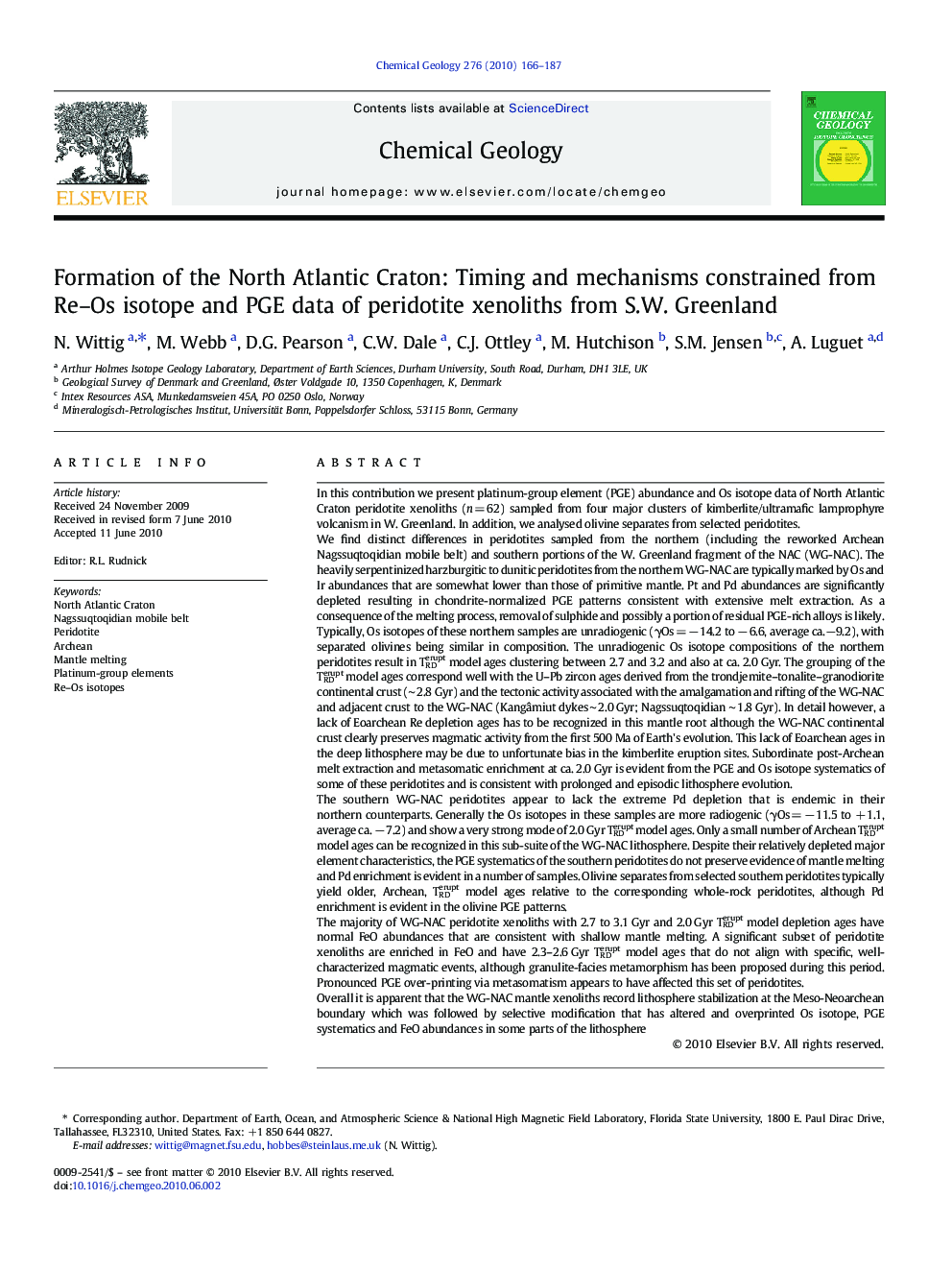| کد مقاله | کد نشریه | سال انتشار | مقاله انگلیسی | نسخه تمام متن |
|---|---|---|---|---|
| 4700015 | 1637683 | 2010 | 22 صفحه PDF | دانلود رایگان |

In this contribution we present platinum-group element (PGE) abundance and Os isotope data of North Atlantic Craton peridotite xenoliths (n = 62) sampled from four major clusters of kimberlite/ultramafic lamprophyre volcanism in W. Greenland. In addition, we analysed olivine separates from selected peridotites.We find distinct differences in peridotites sampled from the northern (including the reworked Archean Nagssuqtoqidian mobile belt) and southern portions of the W. Greenland fragment of the NAC (WG-NAC). The heavily serpentinized harzburgitic to dunitic peridotites from the northern WG-NAC are typically marked by Os and Ir abundances that are somewhat lower than those of primitive mantle. Pt and Pd abundances are significantly depleted resulting in chondrite-normalized PGE patterns consistent with extensive melt extraction. As a consequence of the melting process, removal of sulphide and possibly a portion of residual PGE-rich alloys is likely. Typically, Os isotopes of these northern samples are unradiogenic (γOs = − 14.2 to − 6.6, average ca.−9.2), with separated olivines being similar in composition. The unradiogenic Os isotope compositions of the northern peridotites result in TRDerupt model ages clustering between 2.7 and 3.2 and also at ca. 2.0 Gyr. The grouping of the TRDerupt model ages correspond well with the U–Pb zircon ages derived from the trondjemite–tonalite–granodiorite continental crust (∼ 2.8 Gyr) and the tectonic activity associated with the amalgamation and rifting of the WG-NAC and adjacent crust to the WG-NAC (Kangâmiut dykes ∼ 2.0 Gyr; Nagssuqtoqidian ∼ 1.8 Gyr). In detail however, a lack of Eoarchean Re depletion ages has to be recognized in this mantle root although the WG-NAC continental crust clearly preserves magmatic activity from the first 500 Ma of Earth's evolution. This lack of Eoarchean ages in the deep lithosphere may be due to unfortunate bias in the kimberlite eruption sites. Subordinate post-Archean melt extraction and metasomatic enrichment at ca. 2.0 Gyr is evident from the PGE and Os isotope systematics of some of these peridotites and is consistent with prolonged and episodic lithosphere evolution.The southern WG-NAC peridotites appear to lack the extreme Pd depletion that is endemic in their northern counterparts. Generally the Os isotopes in these samples are more radiogenic (γOs = − 11.5 to + 1.1, average ca. − 7.2) and show a very strong mode of 2.0 Gyr TRDerupt model ages. Only a small number of Archean TRDerupt model ages can be recognized in this sub-suite of the WG-NAC lithosphere. Despite their relatively depleted major element characteristics, the PGE systematics of the southern peridotites do not preserve evidence of mantle melting and Pd enrichment is evident in a number of samples. Olivine separates from selected southern peridotites typically yield older, Archean, TRDerupt model ages relative to the corresponding whole-rock peridotites, although Pd enrichment is evident in the olivine PGE patterns.The majority of WG-NAC peridotite xenoliths with 2.7 to 3.1 Gyr and 2.0 Gyr TRDerupt model depletion ages have normal FeO abundances that are consistent with shallow mantle melting. A significant subset of peridotite xenoliths are enriched in FeO and have 2.3–2.6 Gyr TRDerupt model ages that do not align with specific, well-characterized magmatic events, although granulite-facies metamorphism has been proposed during this period. Pronounced PGE over-printing via metasomatism appears to have affected this set of peridotites.Overall it is apparent that the WG-NAC mantle xenoliths record lithosphere stabilization at the Meso-Neoarchean boundary which was followed by selective modification that has altered and overprinted Os isotope, PGE systematics and FeO abundances in some parts of the lithosphere
Research Highlights
► Formation of Archean subcontinental lithospheric mantle.
► Diamond potential in Greenland.
► Platinum group element fractionation.
Journal: Chemical Geology - Volume 276, Issues 3–4, September 2010, Pages 166–187